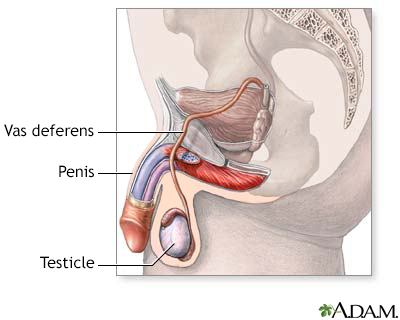Pregnancy SmartSiteTM
Cancer - penis; Squamous cell cancer - penis; Glansectomy; Partial penectomy DefinitionPenile cancer is cancer that starts in the penis, an organ that makes up part of the male reproductive system. CausesCancer of the penis is rare. Its exact cause is unknown. However, certain risk factors include:
The cancer usually affects middle age and older men. SymptomsEarly symptoms may include:
As the cancer advances, symptoms may include:
Exams and TestsThe health care provider will perform a physical exam and ask about your health history and symptoms. A biopsy of the growth is needed to determine if it is cancer. TreatmentTreatment depends on the size and location of the tumor and how much it has spread. Treatment for penile cancer may include:
If the tumor is small or near the tip of the penis, surgery may be done to remove only the cancerous part of the penis where the cancer is found. Depending on the exact location, this is called a glansectomy or partial penectomy. Laser surgery may be used to treat some tumors. For more severe tumors, total removal of the penis (total penectomy) is often needed. A new opening will be created in the groin area to allow urine to exit the body. This procedure is called a urethrostomy. Chemotherapy may be used along with surgery. Radiation therapy may be used along with surgery. A type of radiation therapy called external beam therapy is often used. This method delivers radiation to the penis from outside the body. This therapy is most often performed 5 days a week for 6 to 8 weeks. Outlook (Prognosis)The outcome can be good with early diagnosis and treatment. Urination and sexual function can often be maintained. Possible ComplicationsUntreated, penile cancer can spread to other parts of the body (metastasize) early in the disease. When to Contact a Medical ProfessionalContact your provider if symptoms of penile cancer develop. PreventionCircumcision may decrease the risk. Men who are not circumcised should be taught at an early age the importance of cleaning beneath the foreskin as part of their personal hygiene. Safer sexual practices, such as abstinence, limiting the number of sexual partners, and using condoms to prevent HPV infection, may decrease the risk of developing cancer of the penis. ReferencesHeinlen JE, Ramadan MO, Stratton K, Culkin DJ. Cancer of the penis. In: Niederhuber JE, Armitage JO, Kastan MB, Doroshow JH, Tepper JE, eds. Abeloff's Clinical Oncology. 6th ed. Philadelphia, PA: Elsevier; 2020:chap 82. National Cancer Institute website. Penile cancer treatment (PDQ) - health professional version. www.cancer.gov/types/penile/hp/penile-treatment-pdq#link/_1. Updated February 2, 2022. Accessed October 13, 2022. | |
| |
Review Date: 8/15/2022 Reviewed By: Todd Gersten, MD, Hematology/Oncology, Florida Cancer Specialists & Research Institute, Wellington, FL. Review provided by VeriMed Healthcare Network. Also reviewed by David C. Dugdale, MD, Medical Director, Brenda Conaway, Editorial Director, and the A.D.A.M. Editorial team. The information provided herein should not be used during any medical emergency or for the diagnosis or treatment of any medical condition. A licensed medical professional should be consulted for diagnosis and treatment of any and all medical conditions. Links to other sites are provided for information only -- they do not constitute endorsements of those other sites. No warranty of any kind, either expressed or implied, is made as to the accuracy, reliability, timeliness, or correctness of any translations made by a third-party service of the information provided herein into any other language. © 1997- A.D.A.M., a business unit of Ebix, Inc. Any duplication or distribution of the information contained herein is strictly prohibited. | |

 Male reproductive ...
Male reproductive ... Male reproductive ...
Male reproductive ...
